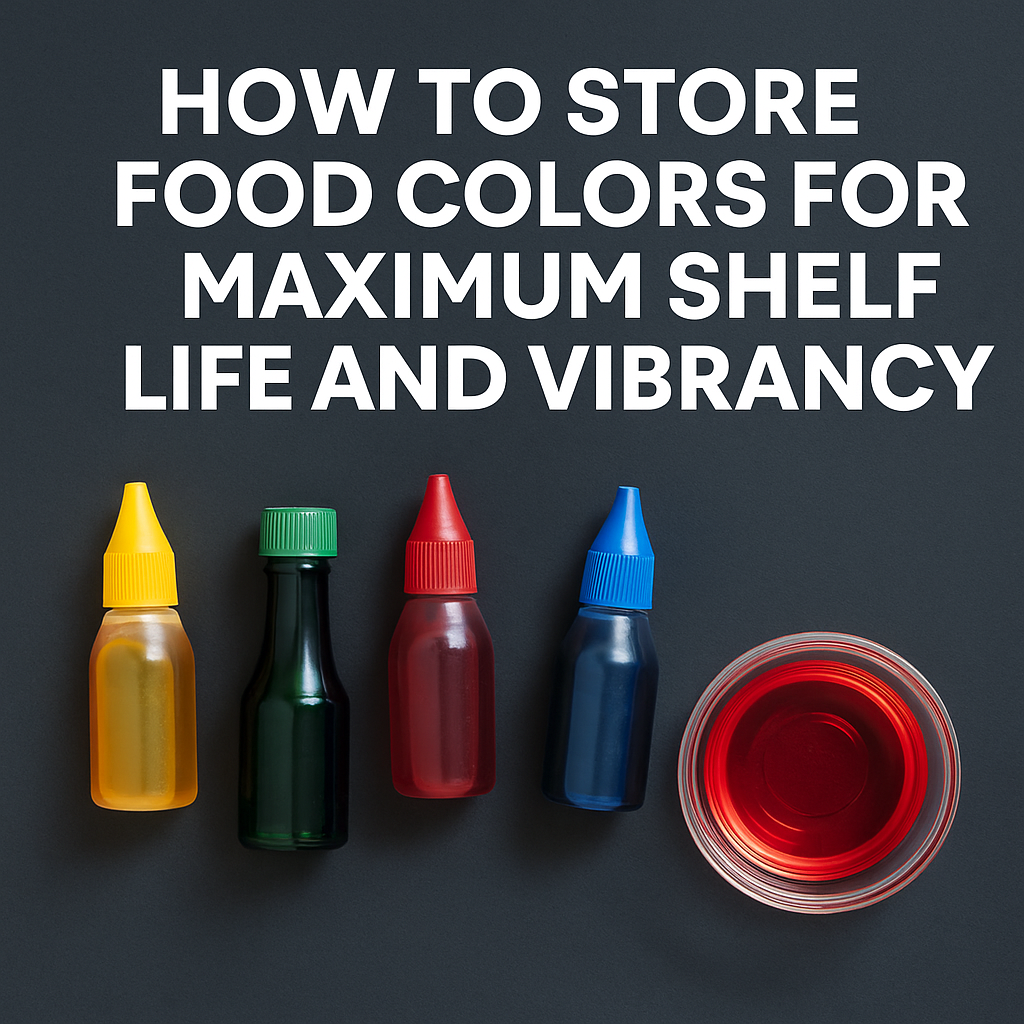Food colors are essential for making your cakes, cookies, and desserts look attractive. But if they lose their brightness or expire too soon, even the best recipe can look dull. Knowing how to store food colors correctly ensures they stay vibrant and last longer. In this blog, we will explore practical tips, storage tricks, and common mistakes to avoid for food color storage.
Why Proper Food Color Storage Matters
Improper storage can reduce the lifespan and vibrancy of your colors. Heat, sunlight, moisture, and contamination can make them clump, fade, or lose consistency. By following proper food color storage tips, you can keep them safe for months, reduce waste, and always have bright, ready-to-use colors for your baking projects.
-
Keep Food Colors in a Cool and Dry Place
Temperature and humidity play a big role in keeping food colors vibrant. Heat can break down pigments, while moisture can cause powdered colors to clump and liquid colors to separate. Store your food colors in a cupboard or pantry away from stoves, ovens, and other heat sources. A cool, dry place is ideal for maintaining their shelf life and appearance.
-
Avoid Direct Sunlight for Longer Shelf Life
Sunlight can fade food colors over time. Even bottles with colored lids cannot fully block UV rays. Store your food colors in dark or opaque containers to protect them from sunlight. This simple step preserves the intensity and richness of your colors for longer.
-
Seal Containers Properly After Each Use
Air exposure is one of the main reasons food colors spoil. Oxidation can cause liquid or gel colors to lose vibrancy, while powdered colors can harden. Always close the lid tightly after use. For powders, transferring them into airtight jars can help maintain freshness. Proper sealing is an essential part of food color storage.
-
Store Gel, Liquid, and Powder Colors Separately
Different types of food colors require different storage conditions. Powdered colors can remain at room temperature, but liquid and gel colors last longer in the fridge. Keeping them separate ensures each type maintains its consistency and color intensity. This is a simple but effective food color storage tip that many people overlook.
-
Use Clean Tools to Prevent Contamination
Using dirty spoons or brushes can introduce bacteria or moisture into food colors, shortening their shelf life. Always use dry and clean utensils. This is particularly important for gel and liquid colors. Maintaining hygiene prevents clumping, bad odors, and changes in color, which is a key step in keeping food colors vibrant.
-
Refrigerate Liquid and Gel Food Colors
While powdered colors are stable at room temperature, liquid and gel colors benefit from refrigeration, especially in hot climates. Keeping them in the fridge slows down separation and helps retain their brightness. Make sure the container is tightly sealed to avoid absorbing other food smells. Refrigeration is an effective method for extending the shelf life of food colors.
-
Check Expiration Dates Regularly
Even with the best storage, food colors have a limited shelf life. Always check the expiration date before use. Expired colors may fade, smell odd, or change consistency. Keeping track of purchase dates helps you use older colors first, reducing waste. This is one of the simplest but most important food color storage tips.
-
Avoid Frequent Temperature Changes
Moving food colors between hot and cold environments repeatedly can affect their quality. For example, taking gel colors from the fridge and leaving them in a hot kitchen can create condensation. Condensation can change the texture of gels and cause powders to clump. Stable storage conditions help in keeping food colors fresh and bright.
Check out our blog: How Temperature Affects the Look of Food Colors During Baking
Tips for Powdered Food Colors
Powdered colors are easier to store but need care too. Keep them in airtight containers and away from moisture. Adding a small food-safe silica packet can prevent clumping. Avoid using plastic bags for long-term storage as they can allow air and humidity inside. These small steps are essential for maintaining powdered food color shelf life.
Signs Your Food Colors Have Gone Bad
Knowing when food colors are no longer usable helps prevent ruined recipes. Gel colors that separate or become watery, powders that clump or smell strange, and liquid colors that lose intensity are signs they have expired. Using expired colors affects both appearance and taste. Monitoring your food color storage regularly ensures you always use fresh colors.
How to Store Food Colors for Maximum Shelf Life
To summarize, the key steps for how to store food colors include keeping them in a cool, dry place, avoiding sunlight, sealing containers tightly, using clean tools, refrigerating gels and liquids if needed, and checking expiration dates. Consistent storage practices maintain vibrancy and extend food color shelf life, making your baking and cooking more colorful and attractive.
Conclusion
Proper food color storage is essential for keeping your baking projects bright and professional. Following these tips helps your colors last longer, stay fresh, and maintain their intensity. At EFA, you can find high-quality food colors, gel and liquid colors, cocoa powder, and other baking essentials. Explore our collection to make your desserts look more colorful and appealing.

